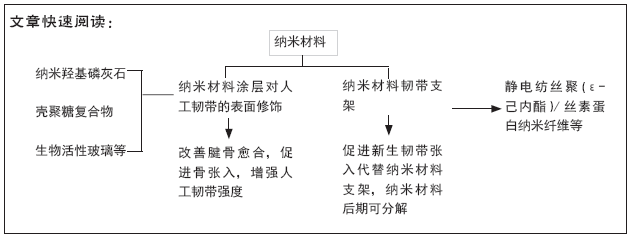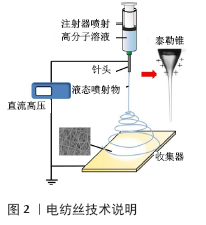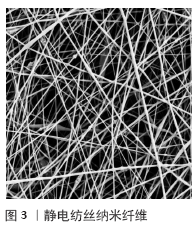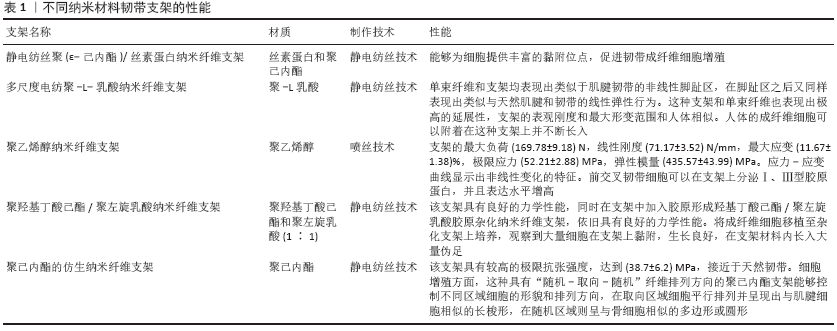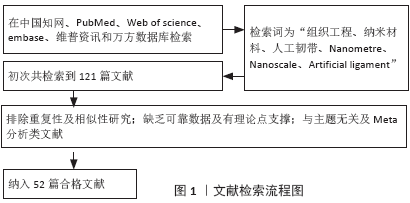[1] LIU CF, ASCHBACHER-SMITH L, BARTHELERY NJ, et al. What we should know before using tissue engineering techniques to repair injured tendons: a developmental biology perspective. Tissue Eng. 2011;B(17): 165-176.
[2] FRANK CB, JACKSON DW. The science of reconstruction of the anterior cruciate ligament. J Bone Joint Surg Am.1997;79(10):1556-1576.
[3] LANGE R, VACANTI JP. Tissue engineering. Science. 1993;260(5110): 920-926.
[4] SUBRAMONY SD, SU A, YEAGER K, et al. Combined effects of chemical priming and mechanical stimulation on mesenchymal stem cell differentiation on nanofiber scaffolds. J Biomech. 2014;4(9):2189-2196.
[5] HAMIDO F, Al HARRAN H, Al MISFER AR, et al. Augmented short undersized hamstring tendon graft with LARS artificial ligament versus fourstrand hamstring tendon in anterior cruciate ligament reconstruction:preliminary results. Orthop Traumatol Surg Res. 2015; 101(5):535-538.
[6] 施犇,陈烁,周立武,等.自体腘绳肌腱与LARS韧带重建前交叉韧带中期疗效比较[J].中国矫形外科杂志,2018,26(16):1005-8478.
[7] LI H, TAO H, CHO S, et al. Difference in graft maturity of the reconstructed anterior cruciate ligament 2 years postoperatively: a comparison between autografts and allografts in young men using clinical and 3.0-T magnetic resonance imaging evaluation. Am J Sports Med.2012;40(7):1519-1526.
[8] 潘知常.前交叉韧带重建移植材料的进展[J].世界最新医学信息文摘,2018,18(5):1671-3141.
[9] SACCOMANNI B. Graft fixation alternatives in anterior cruciate ligament reconstruction. Musculoskelet Surg. 2011;95(3):183-191.
[10] 陈天午,蒋佳,陈世益.人工韧带的临床应用现状及进展[J].宁夏医学杂志,2016,38(8):1001-5949.
[11] 黄建明.GRGDSPC多肽表面修饰PET人工韧带促进腱骨愈合的实验[D].上海:中国人民解放军海军军医大学,2013.
[12] HUANG JM, LIU HY, CHEN FR, et al. Characteristics of bone tunnel changes after anterior cruciate ligament reconstruction using Ligament Advanced Reinforcement System artificial ligament. Chin Med J. 2012; 125(22):3961-3965.
[13] KOBAYASHI M, WATANABE N, OSHIMA Y, et al. The fate of host and graft cells in early healing of bone tunnel after tendon graft. Am J Sports Med. 2005;33(12):1892-1897.
[14] NEBELUNG W, WUSCHECH H. Thirty-five years of follow-up of anterior cruciate Ligament-deficient knees in high-level athletes. Arthroscopy. 2005;21(6):696-702.
[15] WANG X, LI Y, WEI J, et al. Development of biomimetic nanohydroxyapatite/poly(hexamethylene) composites. Biomaterials. 2002;23(24):4787-4791.
[16] KUBASIEWICZ-ROSS P, HADZIK J, SEELIGER J, et al. New Nano-Hydroxyapatite in Bone Defect Regeneration: A Histological Study in Rats. Ann Anat. 2017;213:83-90.
[17] OLIVEIRA HL, DA ROSA WLO, CUEVAS-SUAREZ CE.Histological Evaluation of Bone Repair With Hydroxyapatite: A Systematic Review.Calcif Tissue Int. 2017;101(4):341-354.
[18] LIU Y, WANG G, GAI Y, et al. In vitro effects of nanophase hydroxyapatite Particles on proliferation and osteogenic differentiation of bone marrow-Derived mesenchymal stem cells. J Biomed Mater Res A. 2009; 90(4):1083-1091.
[19] HE Y, DONG Y, CUI F, et al. Ectopic osteogenesis and scaffold biodegradation of nano-hydroxyapatite-chitosan in a rat mode. PLoS One. 2015;10(8):e0135366.
[20] JIANG J, WAN F, YANG J, et al.Enhancement of osseointegration of polyethylene terephthalate artificial ligament by coating of silk fibroin and depositing of hydroxyapatite. Int J Nanomedicine. 2014;9: 4569-4580.
[21] STROBEL LA, HILD N, MOHN D, et al. Novel strontium-doped bioactive glass nanoparticles enhance proliferation and osteogenic differentiation of human bone marrow stromal cells. Nanopart Res. 2013;15(7):1-9.
[22] LI H, GE Y, WU Y, et al. Hydroxyapatite coating enchances polyethylene terephthalate artificial ligament graft osseiontegration in the bone tunnel. Int Orthop. 2011;35(10):1561-1567.
[23] BARBUCCI R, TORRICELLI P, MILENA F, et al. Proliferative and re-defferentiative effects of photo-immobilized mi-cro-patterned hyaluronan surfaces on chondrocyte calls. Biomaterials. 2005;26(36): 7596-7605.
[24] YANG X, CHEN X, WANG H. Acceleration of osteogenic differentiation of preosteoblastic cells by chitosan containing nanofibrous scaffolds. Biomacromolecules.2009;10(10):2772-2778.
[25] 陈世益,蒋佳,吴凌翔,等.PET人工韧带材料纳米化对骨髓基质干细胞粘附、增殖及分化影响的实验研究[J].中国运动医学杂志, 2010,29(5):1000-6710.
[26] 黄棣,李吉东,左奕,等.壳聚糖修饰纳米羟基磷灰石/聚酰胺复合多孔支架的制备和性能研究[J].功能材料,2009,40(7):1175-1178.
[27] MARKAKI AE, WILLIAM C. Magneto-mechanical stimulation of bone growth in a bonded array of ferromagnrtic fibres. Biomaterials. 2004; 25(19):4805-4815.
[28] 俞斌,丁惠锋,杨超华,等.Fe3O4涂层多巴胺修饰PET人工韧带对MC3T3-E1细胞粘附、分化影响的实验研究[J].中国运动医学杂志,2016,35(5):438-444.
[29] LI Y, SHI Y, DUAN S, et al. Electrospun biodegradable polyorganophosphazene fibrous matrix with poly(dopamine)coating for bone regeneration. Biomed Mater Res A.2014;102(11):3894-902.
[30] WOO SL, DEBSKI RE, ZEMINSKI J, et al. Injury and repair of ligaments and tendons. Annu Rev Biomed.2000;2:83-118.
[31] CHEN J, XU J, WANG A, et al. Scaffolds for tendon and ligament repair:Review of the efficacy of commercial products. Expert Rev Med Devices. 2014;6(1):61-73.
[32] MOSHIRI A, ORYAN A. Tendon and Ligament Tissue Engineering,Healing and Regenerative Medicine. Sport Med.Doping Stud. 2013;3(3): 2161-0673.
[33] MOSHIRI A, ORYAN A. Role of tissue engineering in tendon reconstructive surgery and regenerative medicine: Current concepts, approaches and concerns. Hard Tissue. 2012;1(1):2050-2303.
[34] WALDEN G, LIAO X, DONELL S, et al. A Clinical,Biological,and Biomaterials Perspective into Tendon Injuries and Regeneration. Tissue Eng. 2017;23(1):44-58.
[35] 钱宇娜,李林昊,李海滨,等.静电纺丝聚(ε-己内酯)/丝素蛋白纳米纤维支架应用于韧带组织工程修复[J].医用生物力学,2009, 24(S1):147.
[36] SENSINI A, GUALANDI C, FOCARETE ML. Multiscale hierarchical bioresorbable scaffolds for the regeneration of tendons and Ligaments. Biofabrication. 2019;11(3):035026.
[37] 白利明,陈鸿辉,叶春婷,等.编织聚乙烯醇支架材料构建前交叉韧带的生物相容性和力学性能分析[J].中国矫形外科杂志,2009, 17(10):769-773.
[38] 葛泉波,何淑兰,毛津淑,等.生物材料与细胞相互作用及表面修饰[J].化学通报,2005,68(1):43-48.
[39] 陈辉,张春礼,杨清芳,等.新型前交叉韧带支架材料的构建及其生物相容性的实验[J].科学技术与工程,2007,7(24):6305-6308.
[40] 林子锋.基于聚己内酯的仿生韧带构建前十字交叉韧带组织工程的实验研究[D].广州:华南理工大学,2017.
[41] YANG K, WAN J, ZHANG S, et al. In vivo pharmacokinetics,long-term biodistribution,and toxicology of PEGylated graphene in mice. ACS Nano. 2011;5(1):516-22.
[42] LA WG, PARK S, YOON HH, et al. Delivery of a therapeutic protein for bone regeneration from a substrate coated with graphene oxide. Small. 2013;9(23):4051-4060.
[43] LI X, XIE J, LIPNER J, et al. Nanofiber scaffolds with gradations in mineral content for mimicking the tendon-to-bone insertion site. Nano Lett. 2009;9(7):2763-2768.
[44] RAMALINAGM M, YOUNG MF, THOMAS V, et al. Nanfibe scaffold gardients for tissue engineering. J Biomater Appl. 2013;27(6):695-705.
[45] CROSS LM, THAKUR A, JALILI NA, et al. Nanoengineered biomaerials for repair and regeneration of orthopedic tissue interfaces. Acta Biomater. 2016;42:2-17.
[46] KOLLURU PV, LIPNER J, LIU W, e tal. Strong and tough mineralized PLGA nanofibers for tendon-to-bone scaffolds. Acta Biomater. 2013; 9(12):9442-9450.
[47] HE J, QIN T, LIU Y, et al. Electrospinning of nanofibrous scaffolds with continuous structure and material gradients. Mater Lett.2014;137:393-397.
[48] CRISCENTI G, LONGONI A, LUCA AD,et al.Triphasic scaffolds for the regeneration of the bone-ligament interface. Biobabrication. 2016; 8(1):015009.
[49] LI L, ZHENG X, FAN D, et al. Release of celecoxib from a bi-layer biomimetic tendon sheath to prevent tissue adhesion. Mater Sci Eng C. 2016;61:220-226.
[50] ZHAO X, JIANG S, LIU S, et al. Optimization of intrinsic and extrinsic tendon healing through controllable watersoluble mitomycin-C release from electrospun fibers by mediating adhesion-related gene expression. Biomaterials. 2015;61:61-74.
[51] LIU S, ZHAO J, RUAN H, et al. Biominmetic Sheath Membrane via Electrospinning for Antiadhesion of Repaired Tendon.Biomacromolecules. 2012;13(11):3611-3619.
[52] EVROVA O, HOUSKA J, WELTI M, et al. Bioactive, Elastic, and Biodegradable Emulsion Electrospun DegraPol Tube Delivering PDGF-BB for Tendon Rupture Rapair. Macromol Biosci. 2016;16(7): 1048-1063. |
